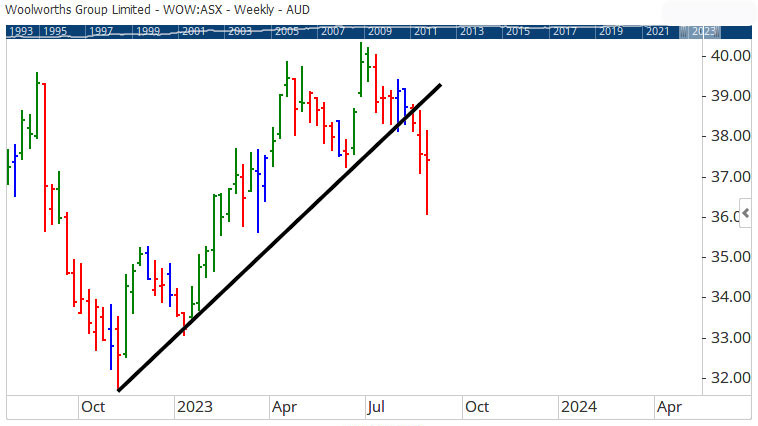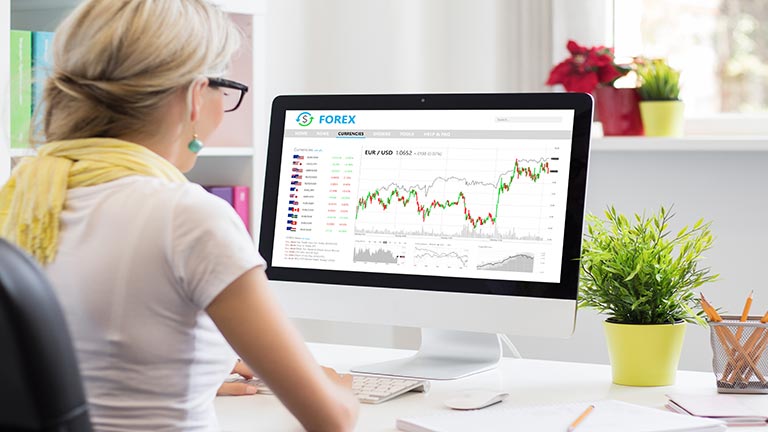What is a Stop Loss & Why Should You Use One

By Dale Gillham
Here's what you need to know about stop-losses – what they are and how to apply them. We also discuss stop-loss orders and when and where you should use them.

What is a stop-loss?
Simply put, a stop-loss is a price point, also known as a trigger price point, at which you commit to selling your shares. As trading is about minimising risk, this tool is used to preserve capital when a recently entered trade doesn't perform or to protect the gains of a winning trade.
When applying stop-losses, you need to decide on your exit strategy before you execute a trade, as it is usually too late to do this when the stock is falling. Most investors make emotional rather than rational decisions when holding or selling a stock. It's also hard to admit, once you enter a trade, that you have made a mistake in your analysis, and it's even harder to be objective when losing money.
Types of stop-losses
There are several types of stop-losses you can use as part of an effective trading strategy to preserve your capital.
A percentage-based stop loss is usually set 10 to 15 per cent below your purchase price, depending on the volatility of the stock, as this allows for short-term fluctuations in the price as the stock settles into a trend. Alternatively, you can set your stop loss at a price point where you know with a high probability you may be wrong in your analysis, which is also referred to as a technical stop.
I recommend calculating both stop-losses and using the one with the least amount of loss. Let's look at how to calculate both exit strategies.
Percentage-based stop loss
Let's say you want to buy AMP (ASX: AMP) because you believe it will rise in a nice uptrend. The stock closed on its last day of trading at $1.10, and you want to purchase the stock when the market opens the next day.
Your total trading capital is $10,000, and you want to trade a position size of 20 per cent or $2,000. You also set a stop loss of 15 per cent below your buy price.
It's important when calculating your stop-loss that you use the most recent share price available, which is typically the closing price for the previous day or week, depending on your trading strategy.
Your stop loss calculation would be as follows:
- Your buy price of $1.10 x 15% (percentage stop loss) = $0.17.
- Therefore, your stop loss target is your buy price of $1.10 minus $0.17 = $0.93.
Once the stock closes $0.01 below your stop loss target of $0.93 on any day you would sell, which means your exit price or trigger price point is $0.92.
Calculating the risk of a percentage-based stop loss
When setting a stop loss, you need to calculate the investment risk you are taking with your money because you may decide you do not want to buy the stock if the risk is too high.
As a rule of thumb, you need to ensure you do not risk more than 2 per cent of your total trading capital on any one trade. This rule allows you to stay in the market longer as you gain the required knowledge, skill and experience to become a consistently profitable trader.
Your risk calculation would be:
- $2,000 (position size for the trade) x 15% (stop loss percentage) = $300, the potential loss you will expose yourself to if the trade does not perform.
- $300 (potential loss) divided by $10,000 (your total capital) x 100 = 3%.
If you take this trade using a 15 per cent stop loss, you stand to lose 3 per cent of your total capital, which is above the allowable risk level of no more than 2 per cent.
Consequently, it would be better to reduce your stop loss until you reduce your risk level to 2 per cent or below, which, in this example, would equate to a stop loss target set at 10 per cent or $0.99.
Once you execute the trade in the market, you need to recalculate your stop loss based on the current market price you paid to ensure your stop loss is set at the right price point.
Technical stop
The second stop loss you need to determine to manage your downside risk is the price point where you know with a high probability that you are wrong in your analysis. This exit strategy is determined using your entry rules.
For example, if you bought when a stock crossed above a trend line, you would know your analysis was wrong if the stock traded back down below the lowest low immediately before the stock traded above the trend line. This is because a stock in an uptrend continually achieves higher lows or troughs, but when it makes a lower low, it suggests that the uptrend is failing. Therefore, you would exit to protect your capital.
Example of a technical stop
As you can see on the chart of AMP below, we have two weekly closes above a downtrend line, which is a standard buy signal. The lower red line marks the lowest low before the price trades above the trend line, while the upper green line is where your entry for this trade would have been triggered.

Chart of AMP Limited
After purchasing the stock, the price fell away, which means you would exit the stock at a loss of 8.70 per cent using a technical stop.
Given this, it makes sense to use the technical stop as the exit strategy for this trade rather than the percentage-based stop loss of 10 per cent, as you will exit the trade with the least loss.
Trailing stop loss
Another effective method for preserving capital is to set a trailing stop loss, which involves raising your stop loss as the stock price rises. There are various ways to do this, but the most well-known and one of the easiest methods is to use an uptrend line as your trailing stop loss.
As you can see in the chart of Woolworths (ASX: WOW) below, the trend line is following the stock trend and providing a trailing stop loss to protect capital. If the stock closed below the trend line, you would sell.

Chart of Woolworths Group
Another method is to place your stop loss underneath the last trough on a daily or weekly chart or to sell the stock once it falls 10 to 15 per cent off any high price.
If we continue with the example of AMP above, let's assume the stock has risen to $1.70, and you decide to use a 10 per cent trailing stop loss. If the stock falls 0.01 cent below $1.53 ($1.70 x 10%), you would sell to lock in the profit.
Profit stop loss
It is also common practice for traders to set profit targets when selling stocks, where the exit is set at a pre-determined profit level. In my 30-plus years of experience, this is done because the individual fears losing the profits they have already made, which stems from the fact:
- They don’t have the knowledge to enact a proper trading plan,
- They don’t trust their trading plan, or
- They don’t trust themselves to apply the trading plan properly.
It also explains why people who use this exit strategy generally achieve returns well below their expectations. As the name suggests, a profit-stop loss stops your profits, which defies the golden rule of letting your profits run. I highly recommend you don't use this strategy.
Always let a stock confirm what it will do before you act, which means always trade with solid rules you trust. If you do not trust your rules, then I encourage you to practice until you do.
Setting a suitable stop loss for the market you trade
Selecting an appropriate stop loss comes down to the volatility of the stock, your risk tolerance and your investment strategy.
Setting stop losses on stocks can be challenging. You need to be close enough to your purchase price to ensure you do not lose more than 2 per cent of your total capital on any one trade, yet far enough away that the stock has room to move in case it falls for a short period after you buy into it.
That's why I don't recommend setting a stop loss too tight, say 5 per cent below your purchase price, as it leaves very little room for the stock to move and increases your chances of being stopped out of the trade.
Blue-chip stocks
If you are a medium-term investor, it's a good idea to study the stock to determine if it is subject to volatile swings. Nice-trending blue chip stocks are not usually subject to large swings in price over short periods when they're at the start of an uptrend, although they do tend to rise for two to four weeks before falling for two to four weeks.
With this in mind, you must be prepared for the stock to fall for a few weeks as it gathers momentum in an uptrend. Setting a stop loss of 10 to 15 per cent for nice-trending blue chip stocks is recommended because anything less than 10 per cent will cause too many false triggers, resulting in losses.
Mid-cap and speculative stocks
For mid-capped stocks and speculative stocks that are subject to more significant swings over shorter timeframes, I recommend you set your stop loss at no more than 10 per cent of your buy price.
Declines in mid-cap stocks are often influenced by news, with stocks falling heavily and quickly, so you must preserve your capital. If you get stopped out and the stock starts to rise again, you can always get back in at a lower price.
The most important point to remember when setting stop losses is that the quicker the stock price moves, the more diligent you need to be with your stop loss.
Leveraged markets
After more than three decades of supporting and mentoring traders, it has been my experience that those who attempt to trade leveraged markets, such as Contracts for Difference (CFDs), where you buy and sell the underlying stock without the proper knowledge and with the illusion they know how to, often seek help when they realise they lack the necessary education. The unfortunate outcome is that they typically lose most, if not all, of their capital.
I cannot stress enough that applying stop-losses in this market is critical because the losses are amplified. Two common strategies for protecting your capital when trading leveraged markets include:
- 50% of the previous bar (or 50% of the previous swing if using swing charts) and
- $0.01 below (above) the previous bar (or previous swing).
You may decide that the first option is more suitable for trading CFDs, for example. At the same time, the second option may represent too much risk to your initial position size depending on your entry, the product being traded, and the leverage being applied.
Either way, if all you do after you read this article is apply stop losses in this market, then I have done my job.
Should I place a stop-loss order once I execute a trade?
A stop-loss order is simply an instruction to your broker or online trading platform to close a trade if it moves below a specific price point to protect your capital.
Once the stock trades down to the stop-order price level or beyond (the exit price), the stop-loss order will become a market order, and it will be sold at the best available price. As such, the price at which the trade is executed may vary slightly from the specified trigger price.
I prefer to refrain from using stop-loss orders when executing a trade because it makes traders complacent as they apply a set-and-forget approach to their trading, which gives them a false sense of security. The best traders use all of their knowledge all of the time because they know the market is an emotional beast that changes frequently. As such, the stop loss you set today may not be appropriate when market conditions change. Managing your trades on a daily or weekly basis based on the timeframe you are trading allows you to analyse what is unfolding on the security and act accordingly.
That said, there are times when setting a stop-loss order is necessary, but this will depend on the market you are trading, your knowledge and the time you have available to manage your trade.
Stop-loss order on blue-chip stocks
If you're trading blue-chip stocks and cannot manage your trades because you lead a busy life, you may decide to use a stop-loss order as you will have certainty that you can potentially minimise any further losses.
That said, you need to be aware that the stop-loss order will also be triggered if the stock price gaps down well below the price point you set to exit the trade. If we continue with the example of AMP above, the stop-loss was set at 10 per cent or $0.99. If the price of AMP gapped down to $0.89 when the market opens the next trading day, the stop-loss order will be triggered, given that the stock price has fallen below the stop-loss order price level.
A stop-loss order can also be used as a trailing stop-loss to lock in profits as the stock trends up. Bear in mind that if the stock continues to rise, you may need to adjust your stop-loss order to ensure it is set at the right price point.
While it is rare for blue-chip stocks to gap down, mid-cap and speculative stocks are quite prone to this.
Stop-loss order on mid-cap and speculative stocks
If you're an active trader trading mid-cap or speculative stocks using a stop-loss order, it may trigger the stop order due to short-term fluctuations in the stock price.
This may not be optimal for your profitability as the price may have only briefly dropped below the stop loss level before turning to trade back up. By not placing a stop-loss order, you would have stayed in the trade and potentially realised a profit. I have experienced this exact situation many times, with some trades netting a profit of over 50 per cent.
Stop-loss order in leveraged markets
If you are trading leveraged markets using a broker who is also a market maker, and you can manage the trade, it is not recommended that you use a stop-loss order as you are informing the broker where to take out your position.
It is well known that most traders use similar stop losses, such as support levels or below a recent trough. Given that market makers provide the liquidity in the market as the counterparty to the buyers and sellers, all a market maker needs to do is trigger a sell one-cent below the stop-loss level to trigger the stop-loss orders. Smart traders know this, which is why, in leveraged markets, they either don't set stop-loss orders or they use a stop-loss that is different to the majority of traders.
Stop-limit orders
Stop-limit orders are similar to stop-loss orders but with the added protection of setting a limit order that is only executed at a price you're willing to accept or better.
A stop-limit order comprises a stop price, which converts the order to a sell order and a limit price. Rather than the order converting to a market order to sell, the sell order is converted into a limit order (an order to buy or sell a specific number of shares at a specific price point), which is executed at the limit price.
The benefit of a stop-limit order is that it allows investors more control by setting specific maximum or minimum prices for each order. It also helps to limit the loss with a predetermined price point at which the investor is unwilling to sustain any further losses.
Is there any downside risk of stop-limit orders?
While stop-limit orders guarantee a price limit, there is no guarantee that the order will be executed.
While the stop order may be triggered, the limit order may not be filled because the share price has traded straight through the limit price. That's why it's not a good idea to use this tool when trading stocks that are prone to move fast or are subject to large swings in price.
To wrap up
Applying stop-losses and stop-loss orders are very powerful tools when used effectively.
Whether managing risk to protect your capital from heavy losses or to lock in profits, everyone can benefit from understanding when and how to use stop-losses.
Let me say that trading is not about how much money you can make; it's about how much you do not lose over time. In other words, it is about minimising risk rather than maximising profits.
While placing and enacting stop losses can be challenging, it can have a significant impact on your success and profitability if used correctly. That's why it's essential to take the time to understand the methods behind applying stop losses so you're around to trade another day.
I outline many of these strategies in more detail in my latest award-winning book, Accelerate Your Wealth - It's Your Money, Your Choice. As many who have already read my book have said, it is your ultimate guide to making money in the market, so I encourage you to purchase a copy.
Dale Gillham is one of Australia's most respected analysts with over 30 years of experience in the investment industry, including banking, financial planning, share market education and professional trading. He is the best-selling author of multiple books. He is passionate about ensuring clients receive the highest level of education in the stock market via our share trading and investment course.
Others who read this also enjoyed reading:






